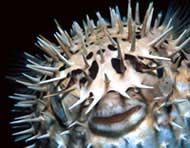Puffer fish raw and rich

The puffer will help pinpoint human genes. <br>© Underwaterphotography.com <br>
Draft Fugu genome will help find human genes.
A draft sequence of the puffer-fish genome is complete. The fish’s compact genetics should accelerate the discovery of human genes and their key controlling sequences.
Gene-prediction programs struggle to find genes in the 3 billion letters of the human sequence, which includes swathes of junk DNA and defunct pseudogenes.
The bony fish Fugu rubripes shares our gene repertoire but has a genome one-eighth of the size. Its sequence “is easier to sift through for genes”, says Greg Elgar of the UK Human Genome Mapping Project Resource Centre in Hinxton, a partner in the international sequencing effort.
The rough sequence covers 99% of Fugu’s DNA. It should help to settle the much-disputed estimate of gene number in humans. Current figures for Fugu are around 35,000-40,000; most recent human approximations are 30,000-40,000.
Crucial sequences that control how actively genes make proteins are also very similar in puffer fish and humans, explains Elgar, despite the fact that their most recent common ancestor lived 45 million years ago.
“[These sequences] are the most exciting targets for therapeutics,” says Elgar. Members of the consortium are now undertaking large-scale genome analyses to pinpoint these regulatory regions.
The Fugu genome project used ’whole-genome shotgun’ sequencing, a technique pioneered by the commercial human-genome sequencers Celera, in which fragments are read and then pieced together.
The draft announcement comes only a year after the consortium, based in the United States, Singapore and the United Kingdom, embarked on the project. They plan to publish an analysis in early 2002 and are making all sequence information freely available.
Media Contact
All latest news from the category: Life Sciences and Chemistry
Articles and reports from the Life Sciences and chemistry area deal with applied and basic research into modern biology, chemistry and human medicine.
Valuable information can be found on a range of life sciences fields including bacteriology, biochemistry, bionics, bioinformatics, biophysics, biotechnology, genetics, geobotany, human biology, marine biology, microbiology, molecular biology, cellular biology, zoology, bioinorganic chemistry, microchemistry and environmental chemistry.
Newest articles

First-of-its-kind study uses remote sensing to monitor plastic debris in rivers and lakes
Remote sensing creates a cost-effective solution to monitoring plastic pollution. A first-of-its-kind study from researchers at the University of Minnesota Twin Cities shows how remote sensing can help monitor and…

Laser-based artificial neuron mimics nerve cell functions at lightning speed
With a processing speed a billion times faster than nature, chip-based laser neuron could help advance AI tasks such as pattern recognition and sequence prediction. Researchers have developed a laser-based…

Optimising the processing of plastic waste
Just one look in the yellow bin reveals a colourful jumble of different types of plastic. However, the purer and more uniform plastic waste is, the easier it is to…



